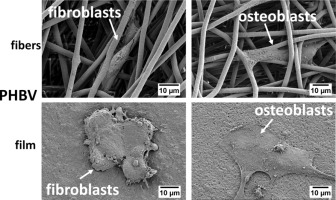Biomaterials Advances ( IF 5.5 ) Pub Date : 2020-01-16 , DOI: 10.1016/j.msec.2020.110668 Łukasz Kaniuk , Zuzanna J. Krysiak , Sara Metwally , Urszula Stachewicz

|
The cellular response is the most crucial in vitro research. Materials' biocompatibility is determined based on cell proliferation and growth. Moreover, the topography of the scaffold surface is the key to enhance cell attachment and anchoring that importantly control further tissue development. Individual cell types have specific preferences regarding the type of surface and its geometry. In our research, we used poly(3-hydroxybutyric acid-co-3-hydrovaleric acid) PHBV to produce two types of substrate: a 3D structure of electrospun fibers and 2D flat films. The PHBV products were morphologically characterized by scanning electron microscopy (SEM). The cytocompatibility was evaluated with cell viability and proliferation using two different types of cells: human osteoblast-like cells (MG-63) and NIH 3 T3 murine fibroblast cells. The behaviour of both cell types was compared on the similar PHBV fiber scaffolds and films using two types of polystyrene (PS) based substrate for the cell culture study: unmodified PS that is not favourable for the attachment of cells and on tissue culture polystyrene (TCPS) plates, which are chemically modify to enhance cells attachment. The results clearly showed high biocompatibility of PHBV as both types of cells showed similar proliferation. These results indicated that PHBV scaffolds are suitable for the development of multifunctional substrates facilitating the growth of different types of tissue regardless of the 3D and 2D designed structures for regeneration purposes.
中文翻译:

成骨细胞和成纤维细胞附着于聚(3-羟基酸共-3- hydrovaleric酸)(PHBV)膜和电纺丝支架
细胞反应是最关键的体外研究。材料的生物相容性取决于细胞的增殖和生长。而且,支架表面的形貌是增强细胞附着和锚定的关键,这重要地控制了进一步的组织发育。各个细胞类型在表面类型及其几何形状方面都有特定的偏爱。在我们的研究中,我们使用聚(3-羟基酸合作-3-氢戊酸)PHBV可生产两种类型的基材:电纺纤维的3D结构和2D平面膜。通过扫描电子显微镜(SEM)对PHBV产物进行形态学表征。使用两种不同类型的细胞:人成骨样细胞(MG-63)和NIH 3 T3鼠成纤维细胞,通过细胞活力和增殖评估了细胞相容性。使用两种类型的基于聚苯乙烯(PS)的基质进行细胞培养研究,在相似的PHBV纤维支架和薄膜上比较了两种细胞类型的行为:未经修饰的PS(不利于细胞的附着)和组织培养聚苯乙烯(TCPS )板,该板经过化学修饰以增强细胞附着力。结果清楚地显示出PHBV的高生物相容性,因为两种类型的细胞均表现出相似的增殖。











































 京公网安备 11010802027423号
京公网安备 11010802027423号